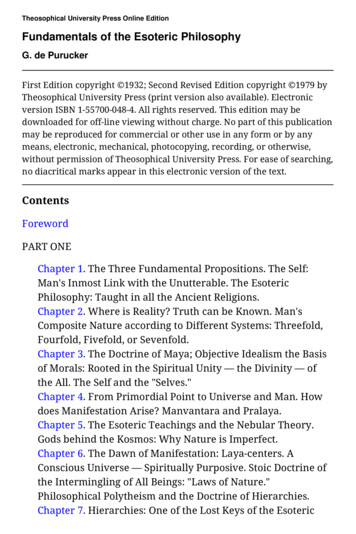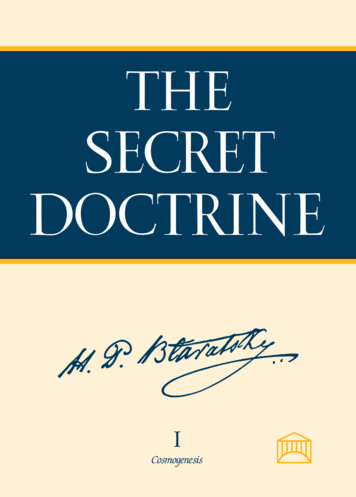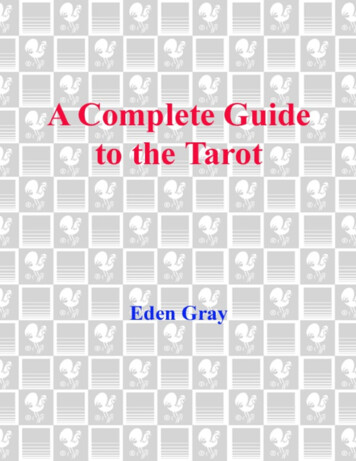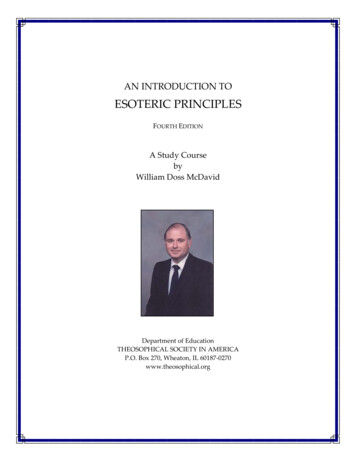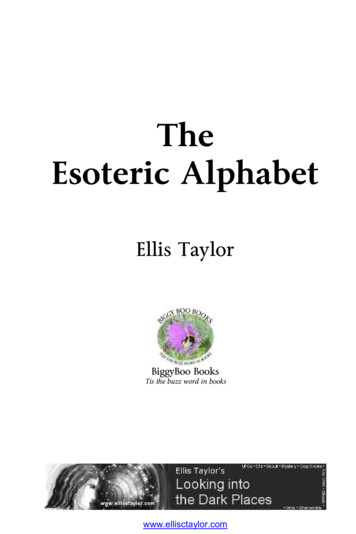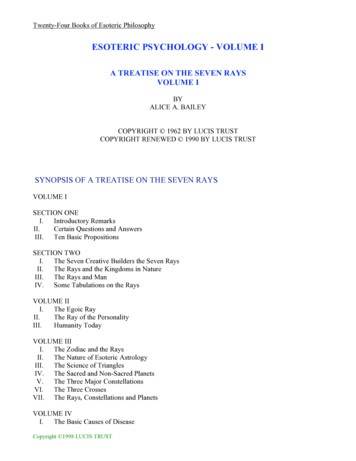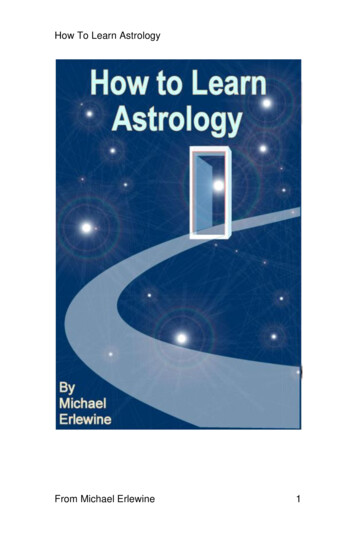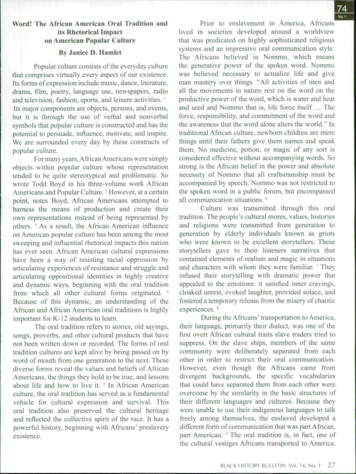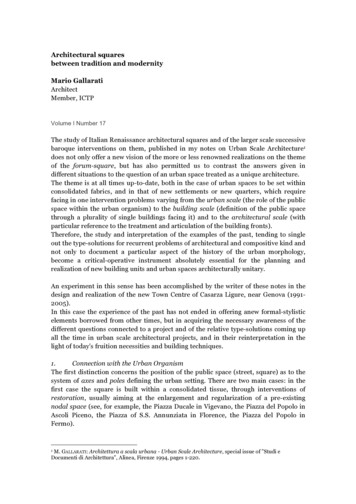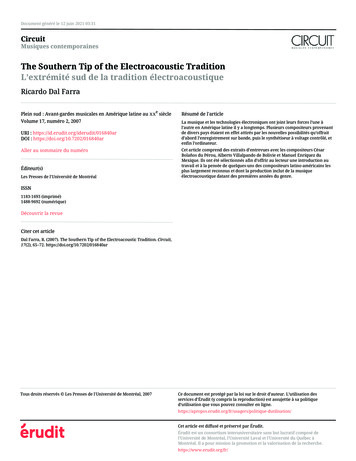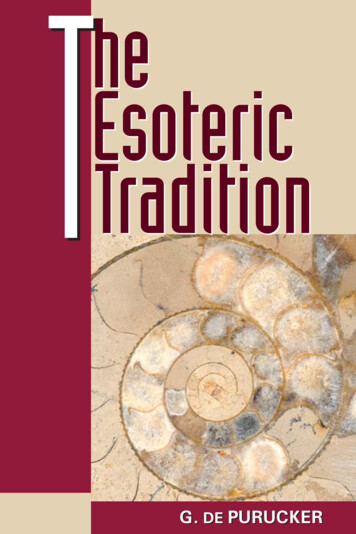
Transcription
heEsotericTraditionG. DE PURUCKER
H. P. Blavatsky pointed to the funda mentalconcepts of The Secret Doctrine (1888) ascomprising the principles of an ancientwisdom existing long before the dawn ofhistory. Underlying and seeding the world’sspiritual traditions, it is this doctrine andwisdom-teaching which G. de Puruckerunfolds in The Esoteric Tradition.This 3rd & Revised edition offers a broad,yet detailed introduction to theosophy,synthesizing philosophy, science, and religion in a way that enables the reader to seeuniverses, worlds, humanity, and all natureas different aspects of one evolving cosmicpattern. And throughout the tapestry runsthe thread of altruism and service as the waytowards bettering all life.Topics include: what theosophy is and isnot; the origin and structure of the universe;karma and reincarnation; cycles of humanevolution; processes of death and rebirth;good and evil; divinity and the Hier ararchyof Compassion; avatars, buddhas, andchrists; mediums vs. mediators; the esotericschools and the great teachers of mankind — these and much more contribute tothe panorama of The Esoteric Tradition.Cover Design: Patrice Hughes
G. de Purucker was born in 1874 at Suffern,New York, son of an Anglican minister wholater served as chaplain of the AmericanChurch in Geneva, Switzerland. There hewas educated in private schools and by tutors,specializing in Hebrew, Latin, and Greek inpreparation for the ministry. However, sub sequent study of the early Church Fathers,Eastern philosophies, and Sanskrit led him totheos ophy with its broad comprehension ofall religions, philosophies, and sciences. Dr.de Purucker was head of the TheosophicalSociety from 1929 until his death in 1942.Perhaps his greatest contribution to spiritualthought has been his elucidation of the writings of H. P. Blavatsky.Free catalog on requestTheosophical University PressPost Office Box CPasadena, California 91109 –7107www.theosociety.org
PHILOSOPHY / RELIGION / SCIENCEH. P. Blavatsky and “The Secret Doctrine”Allegory and mystical symbolismBehind the veils with scienceHow the One becomes the ManyKarma, fatalism, and free willThe evolutionary pathway to the godsHeavens, hells, and after-death statesReimbodiment as taught through the agesMysteries of man’s inner natureSeers vs. visionariesThe secret doctrine of Gautama the BuddhaThe Esoteric SchoolsISBN 978-1-55700-217-49 781557 002174
the esoteric tr adition
by the same author:The Dialogues of G. de PuruckerFountain-Source of OccultismThe Four Sacred SeasonsFundamentals of the Esoteric PhilosophyMan in EvolutionMessages to ConventionsOccult GlossaryThe Path of CompassionQuestions We All AskThe Story of JesusStudies in Occult PhilosophyWind of the Spirit
TheEsotericTraditionG. de Purucker3rd & Revised EditionHTHEOSOPHICAL UNIVER SIT Y PR ESSpa sadena, Califor nia
hTheosophical University PressPost Office Box CPasadena, California 91109-7107www.theosociety.org(626) 798-3378 tupress@theosociety.org20133rd & Revised EditionCopyright 2011 by Theosophical University Press.All rights reserved.First Edition 1935 by G. de PuruckerSecond Edition, 1940ISBN 978-1-55700-216-7 (PDF eBook)ISBN 978-1-55700-217-4 (softcover)Library of Congress Cataloging-in-Publication DataPurucker, G. de (Gottfried), 1874-1942The esoteric tradition / G. de Purucker. — 3rd & revised edition.pages cmThe original two-volume set of The Esoteric Tradition was compiledfrom material dictated by G. de Purucker over the course of some timeand contained much that was repetitious. The major task of editing andcondensing the text was done by A. Studley Hart and Grace F. Knoche.Includes bibliographical references and index.ISBN 978-1-55700-217-4 (pbk. : alk. paper) — ISBN 978-1-55700216-7 (pdf ebook)1. Theosophy. 2. Reincarnation. I. Hart, A. Studley, editor. II. Knoche,Grace F., editor. III. Title.BP565.P8E8 2012299'.934—dc232011053413Manufactured in the United States of America
ContentsForeword to the 3rd & Revised EditionviiTo the ReaderixIntroduction11. Theosophy: the Mother of Religions,Philosophies, and Esoteric Sciences112. Allegory and Mystical Symbolism293. Worlds Visible and Invisible494. How the One Becomes the Many715. Monads, Souls, and Atoms996. The Evolutionary Pathway to the Gods7.On the Evolution of Humanand Animal Beings1271478. The Turning of the Wheel1719.201Behind the Veils with Science10. Webs of Destiny24111. Heavens and Hells27912. Reimbodiment as Taughtthrough the Ages31113. How Man Is Born and Reborn35114. “Life” in Fact and in Theory37915. The Astral Light and the Life-Atoms40116. Death and After:A Study of Consciousness42517. Circulations of the Cosmos451
vi The Esoteric Tradition18. Birth and Before Birth47719. Great Sages and the Cosmic Hierarchy49120. Pneumatology and Psychology:Mysteries of Man’s Inner Nature50921. Great Seers versus Visionaries54122. The Esoteric Schools56123. The Secret Doctrine ofGautama the Buddha58524. Some Misunderstood Teachingsof the Mysteries603Sources Cited627Index633
Foreword to the3rd & Revised EditionThe original two-volume edition of The Esoteric Tradition wascom piled from material dictated by G. de Purucker over the course ofsome time and contained much that was repetitious. The major taskof editing and condensing the text into a single volume was done byA. Studley Hart and Grace F. Knoche. Spelling, capitalization, andforeign transliterations have been modernized, and quotations havebeen rechecked.Randell C. Grubband the TUP editorial staffOctober 23, 2011
To those who have bestowed the Priceless,who have given immeasurably,and to their Sublime Cause,these volumes are offered with measurelessreverence and devotion.
To the Reader(Reprinted from the First Edition)The writing of these volumes has not been an easy task, and thisfor a number of reasons, first and foremost among which hasbeen the lack of leisure-hours to devote to it. Dictation proceededfrom the first page to the last in a hurry and often at high speed, forit was the only way of producing this work within a reasonable timeafter its forthcoming publication had first been mentioned by theauthor in the summer of 1934. Had time been taken to prepare themanuscript in a manner pleasing to the author himself and his coworkers, its appearance might have been delayed for a year or two,or possibly longer. In that event the author would have been ableto follow the most excellent advice offered by the genial Horace, theLatin poet, in his Satires, I, x, 72-3: Saepe stilum vertas, iterum quaedigna legi sint scripturus. However, there has been no time to “reversethe pencil” for the purpose of erasing, nor has there been any leisurefor revision and for the polishing of phrases.It is due in large part to the devotion and enthusiasm of a numberof friends and students attached to the different departments at theInternational Theosophical Headquarters at Point Loma, that TheEsoteric Tradition now at last is given to its readers. To Dr. JosephH. Fussell, who read the proof-sheets and offered valuable suggestions; Miss Helen Savage, who did the secretarial work; Mrs. HazelMinot, responsible for checking and verifying of quotations; Mrs.Guy Ponsonby and Mr. S. Hecht, who prepared the copious index;Miss Elizabeth Schenck, Miss Grace Knoche, and Mr. W. E. Small,who read proof: to these and to all others who have helped in any waywhatsoever to forward the publication of this book, the author giveshis grateful thanks.Special mention should be made of the Theosophical UniversityPress, where everyone, the Manager and the Assistant Manager and
x The Esoteric Traditionall others composing the staff, cooperated to devote what time couldbe set aside from the regular issuing of our various magazines andother routine press-work, to the composition and later printing ofthese volumes.As regards a number of citations appearing in this work and takenfrom books written in languages other than English, mostly in ancienttongues, it may be as well to say that wherever possible the author hasused standard or popular translations, but in certain cases where hefelt better satisfied with his own renderings, he has done the work oftranslation himself.One cannot too often repeat what H. P. Blavatsky pointed out inher ‘Introductory’ to The Secret Doctrine, Vol. I, p. xix:It is above everything important to keep in mind that no theosophicalbook acquires the least additional value from pretended authority.Every Theosophical book must stand on its own ground ofmerit, and if it have demerit greater than its merit, by that demeritit will fall — and the sooner it falls the better for all concerned. Thepresent writer feels this fact very strongly in connection with thesevolumes, his own latest contribution to Theosophical literature; and,although they are for him and his co-workers a labor of pure theosophical devotion and love, he not only expects but desires that thesevolumes shall speak solely for themselves, and shall stand upon theirown grounds of appeal. What is good in them will endure: if there isanything that is not good, let it perish and perish rapidly.Works like this present literary venture are badly needed in theworld today. The dissemination of Theosophical thought amongmen can be aided greatly by new presentations of the age-old veritiespreserved by the Masters of Wisdom and of Compassion from immemorial ages in the past.One is reminded in this connexion of an important letter written by the Master Kuthumi, dated December 10, 1880, and found inthe memorable volume entitled The Mahatma Letters to A. P. Sinnett,transcribed and compiled by A. T. Barker. The following extract fromthis letter is found on pages 23 and 24, as changed, however, by the
To the Reader xiexalted writer’s own corrections to be found on pages 425 and 426 ofthe same book:The truths and mysteries of occultism constitute, indeed, a body ofthe highest spiritual importance, at once profound and practical for theworld at large. Yet, it is not as a mere addition to the tangled mass oftheory or speculation in the world of science that they are being givento you, but for their practical bearing on the interests of mankind.The terms “unscientific,” “impossible,” “hallucination,” “impostor,”have hitherto been used in a very loose, careless way, as implying inthe occult phenomena something either mysterious and abnormal, ora premeditated imposture. And this is why our chiefs have determinedto shed upon a few recipient minds more light upon the subject, . . . .The wiseacres say: “The age of miracles is past,” but we answer, “itnever existed!”. . . [These truths] have to prove both destructive andconstructive — destructive in the pernicious errors of the past, in theold creeds and superstitions which suffocate in their poisonous embracelike the Mexican weed nigh all mankind; but constructive of new institutions of a genuine, practical Brotherhood of Humanity where all willbecome co-workers of nature, will work for the good of mankind withand through the higher planetary Spirits — the only “Spirits” we believein. [From here on the italics represent the ‘corrections’ above referredto.] Phenomenal elements previously unthought of, . . . will disclose atlast the secrets of their mysterious workings. Plato was right to readmitevery element of speculation which Socrates had discarded. The problems ofuniversal being are not unattainable or worthless if attained. . . . “Ideasrule the world”; and as men’s minds receive new ideas, laying asidethe old and effete the world (will) advance; mighty revolutions (will)spring from them; institutions (aye, and even creeds and powers, they mayadd) — will crumble before their onward march. . . . It will be just asimpossible to resist their influence when the time comes as to stay theprogress of the tide. . . . all this will come gradually on; and . . . before itcomes they as well as ourselves, have all a duty to perform, a task set beforeus: that of sweeping away as much as possible the dross left to us by ourpious forefathers. New ideas have to be planted on clean places, forthese ideas touch upon the most momentous subjects. It is not physicalphenomena . . . but these universal ideas that we have precisely to study:the noumenon not the phenomenon, for, to comprehend the latter wehave first to understand the former. They do touch man’s true positionin the Universe, . . . It is not physical phenomena however wonderful that
xii The Esoteric Traditioncan ever explain to man his origin let alone his ultimate destiny, . . . — therelation of the mortal to the immortal, of the temporary to the eternal,of the finite to the Infinite, etc., etc.Verily, it is these “universal ideas” that all should study, and whichby their influence over human minds will bring about the change inhuman consciousness that all true Theosophists work for and aspiretowards, thus helping in the bringing about of that which the Theosophical Society was originally founded in 1875 to introduce.Let it be remembered that there exists a universal and really infallible test or touchstone by which any new increments of Theosophical teaching may be tried, and this test or touchstone is universality.Universality here is equivalent to spirituality; and any teaching whichcan be proved to be universal, in the sense of being accordant withand in concord with all other great teachings of the past — or of thepresent — has high probability of being a true Theosophical verity;and contrariwise, any teaching which cannot be proved to be inherentin and a part of the great deliveries of Theosophical truths in the past,may by the same token be safely rejected as being new in the sense ofdifferent and more or less spurious, because failing to withstand successfully the test just mentioned.In the future, it is the present writer’s hope, if he can find the timeand strength so to do, to publish another volume or two containingTheosophical teaching which up to the
216-7 (pdf ebook) 1. Theosophy. 2. Reincarnation. I. Hart, A. Studley, editor. II. Knoche, Grace F., editor. III. Title. BP565.P8E8 2012 299'.934—dc23 2011053413 Manufactured in the United States of America. Contents Foreword to the 3rd & Revised Edition vii To the Reader ix Introduction 1 1. Theosophy: the Mother of Religions, Philosophies, and Esoteric Sciences 11 2. Allegory and Mystical .File Size: 2MBPage Count: 712
